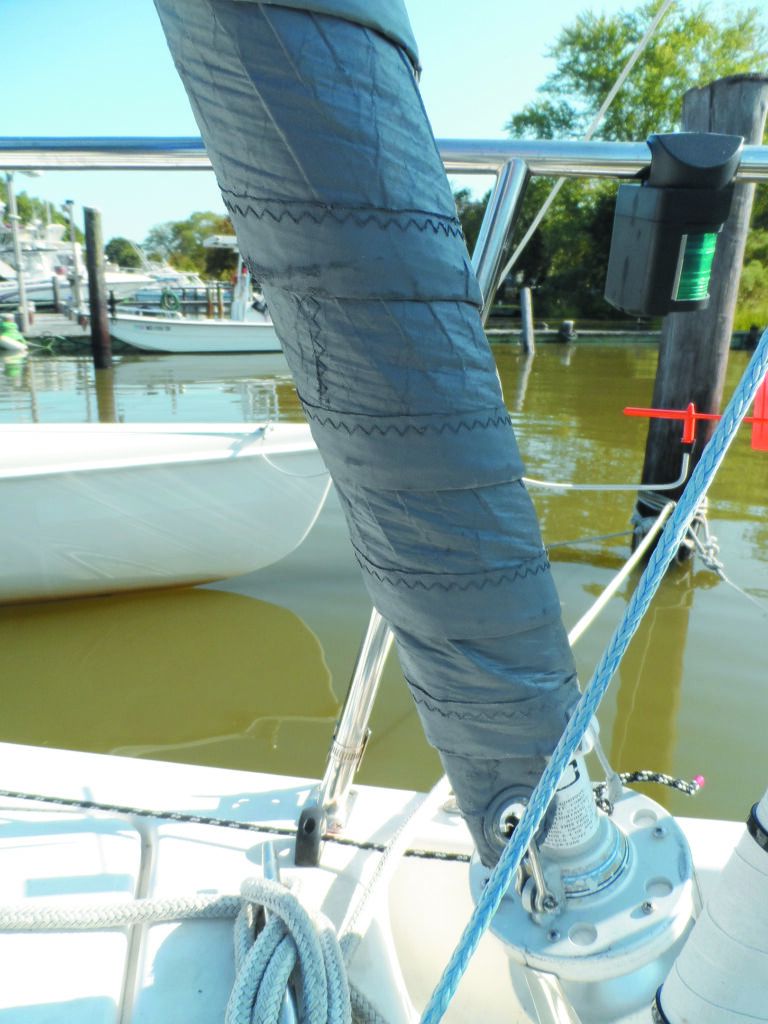What’s that they say about the 10-foot paint job? Sure, if you look closely, it is clear that something is different with the genoa aboard Tech Editor Drew Frye’s F-24 Corsair. Battleship gray is not a common color for the suncover on a recreational sailboat, and the sheen is more reflective than normal. But unless you are aboard the boat, the laminate sail looks like any other genoa with a stitched on suncover. The original Sunbrella suncover exists, only now it is painted with MDR Amazon Inflatable Boat Paint, which also fared well in Practical Sailor’s test of inflatable boat paints.
We asked passersby at the dock what they thought of our new suncover and their responses were complimentary. They did not realize it was painted until we told them. The paint makes the leach and foot of the sail a little bit stiffer than before, but it did not interfere with furling or trim.

Frye has had the newly painted genoa in service for nearly three years. He expected it to last at least that long, and he was right. How long it would last when used regularly, we’ll not know for sure because Frye will be replacing the sail this winter — not because the paint is failing, but because the stitching and fabric of the sail itself is giving out. (We will be preserving a sample of the sail for exposure testing — so we should be able to approximate lifespan.)
Keep in mind that we would not recommend this treatment for a sail that is still in good or better condition. For a sail that is still in good condition, a fabric cover is better. But if you want to get a few more years out of tired old sail without investing in a new suncover, paint is a good alternative. As we saw in our January 2020 test of potential sail paints, these coatings are used at the highest level of sailing. Oddly, there are not yet any paints in the US marketed as sail paints—at least that we are aware of. (We found one in New Zealand, Marine Shield, that has yet to find US distribution.)
For more details on paint selection, prepping and painting your jib (there’s no magic to it, really), see our January 2020 report, “The Case of the Painted Jib.” And if you are keen on improving the upwind performance on that blown-out Dacron cross-cut jib or mainsail without racking up a big bill at the sailmaker, the Tech Editor Drew Frye guides readers through the process of recutting an old sail ( see “Getting the Most Out of Older Sails,” in the January 2022 issue of Practical Sailor. If you’ve got some minor repairs—tears, ripped seams, or luff damage—our comparison of sail repair tapes and glues for sail repairs explores sail repair to a fare-thee-well. A simple search of the website under “sail repair” will turn up several other reports on this topic.
Finally, if you are in the market for new sails, our three part report on sails “A Look at Sails: Complete Series” takes a deep dive into choosing a sailmaker, selecting sail material, design and construction, and key details to include in your next sail, whether it’s a cruising mainsail, a furling gennaker, storm trysail, or anything in between.








































The most this article or the original in Dec 2019 says about preparation is in the caption to a photo that says, “After cleaning with a solvent, rinsing and taping, Frye was ready to lay down the first of two coats of paint.”
Please elaborate. What solvent?
Note, that unless you have a large hard (and “solvent” resistant) work surface as in the photo, plus cooperative weather, this is not a simple job.
The solvent was xylene; it is good for removing tape residue from wind ribbons. I only spot-cleaned to remove tape residue spots, and you could skip that step. The sail was washed because it had not been in umpteen years and needed it (lightly brushed with the sail laid out flat using Formula B, and hosed it off). The work surface was an asphalt driveway that we cleared with a leaf blower and covered with old sheets. Nothing fancy.
The original article in January 2020.
I’m confused as to whether the whole sail was painted or just the sun cover?
I am confused, too. Was the whole sail painted or just the sun cover?